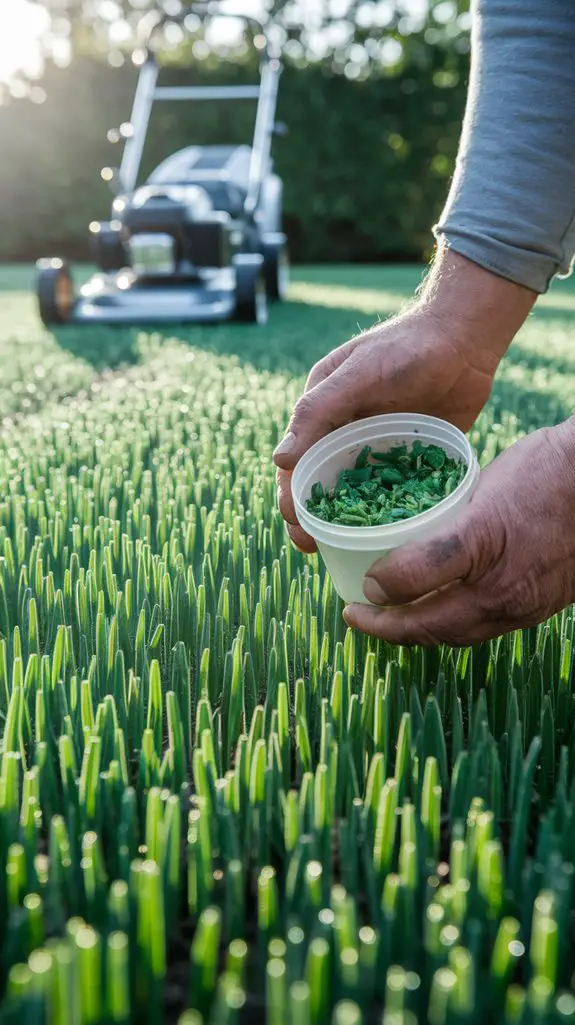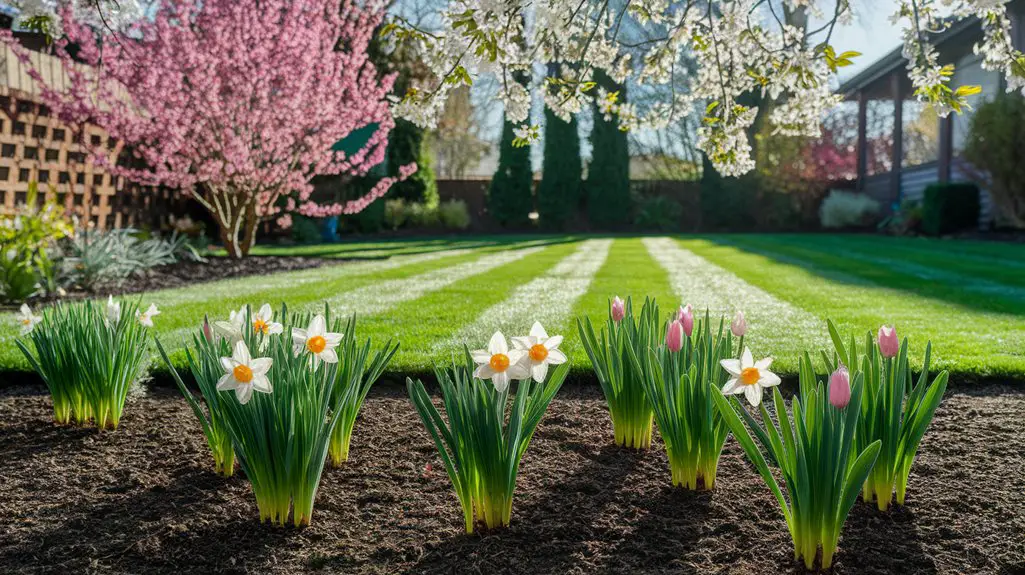Is your lawn languishing after winter’s harsh embrace? Your spring lawn care regimen serves as the critical awakening period that determines your turf’s resilience throughout the entire growing season. You’ll need to understand both the biological reactivation processes and strategic intervention timing to optimize recovery. Proper spring care addresses winter damage while establishing strong root systems before summer stress arrives. The techniques you implement now will greatly impact your lawn’s health for months to come.
Winter Damage Assessment: Identifying Recovery Needs
Three critical types of winter damage require immediate assessment as temperatures rise: frost heave, snow mold, and desiccation.
Frost heave occurs when soil repeatedly freezes and thaws, pushing grassroots upward and exposing them to air. You’ll notice unevenness and exposed roots requiring prompt re-compaction and topdressing.
Snow mold manifests as circular patches of matted, discolored grass, typically appearing where snow lingered longest. Pink (Microdochium nivale) and gray (Typhula incarnata) variants require different fungicidal approaches based on proper identification.
Desiccation damage presents as brown, brittle grass caused by winter winds that strip moisture from exposed turf.
You’ll need to evaluate tissue viability by examining crown areas—green tissue indicates recovery potential through proper hydration and fertilization, while complete browning necessitates reseeding affected zones. Additionally, understanding essential lawn care tips can help you implement effective recovery strategies for your backyard.
The Science Behind Spring Grass Awakening

While winter damage assessment focuses on recovery needs, understanding the biological processes that drive spring green-up illuminates ideal timing for your first lawn interventions.
Grass awakening occurs when soil temperatures consistently reach 50-55°F (10-13°C), triggering hormonal changes within dormant crowns. This temperature threshold activates enzymes that catalyze stored carbohydrates into energy for new growth.
Simultaneously, photoreceptor proteins detect lengthening daylight hours, signaling cellular division in meristematic tissue. You’ll notice roots reactivate before visible blade growth, as they’re developing essential nutrient uptake pathways.
Different grass species exhibit varied temperature requirements – cool-season varieties (fescue, bluegrass) green up at lower temperatures than warm-season grasses (Bermuda, zoysia).
Monitoring soil temperature rather than air temperature provides the most accurate biological indicator for timing fertilization and first mowing. Additionally, implementing eco-friendly lawn care practices during this period can further enhance the health and sustainability of your lawn.
Essential Spring Soil Testing and Amendments

Most spring lawn renovation efforts fail without proper soil analysis, as pH imbalances and nutrient deficiencies can negate even the most diligent care regimens.
You’ll need to conduct a thorough soil test identifying your lawn’s current pH level, macronutrient profile, and organic matter content to establish a scientific baseline for amendments.
- Adjust soil pH strategically using lime for acidic soils (below 6.0) or sulfur for alkaline conditions (above 7.0), as proper pH enables ideal nutrient absorption.
- Address macronutrient deficiencies with appropriate fertilizers—using nitrogen (N) for leaf growth, phosphorus (P) for root development, and potassium (K) for stress resistance.
- Incorporate organic amendments like compost at 1/4-inch depth to improve microbial activity, enhance soil structure, and provide slow-release nutrients.
Strategic Lawn Aeration and Dethatching Timelines
Compacted soil and excessive thatch directly impede nutrient absorption, regardless of how perfectly balanced your soil chemistry might be.
For cool-season grasses, schedule core aeration in early spring (March-April) when soil temperatures consistently reach 55°F and roots are actively growing. This prime timing maximizes recovery before summer heat stress begins.
Remove thatch exceeding ½ inch thickness using a dethatching rake or power dethatcher. You’ll achieve superior results by dethatching after the lawn’s initial spring growth spurt but before peak growing season.
For warm-season grasses, delay these operations until soil temperatures maintain 65°F. Post-aeration is the ideal window for overseeding and fertilization, as seeds gain direct soil contact through aeration channels, improving germination rates by approximately 30-50% compared to non-aerated lawns.
Early Season Fertilization: Types and Techniques
The ideal spring fertilization strategy hinges on selecting nitrogen formulations that align with soil temperature thresholds rather than calendar dates.
You’ll achieve peak nutrient absorption when soil consistently maintains 55°F at 4-inch depth—typically when lilacs begin blooming. Slow-release formulations containing 30-50% water-insoluble nitrogen prevent rapid leaf growth while strengthening root systems during this vulnerable change period.
- Apply nitrogen at 0.75-1 lb per 1,000 square feet, adjusting ratios based on soil test phosphorus and potassium deficiency indicators.
- Consider enhanced-efficiency fertilizers with urease inhibitors if your region anticipates heavy spring precipitation.
- Supplement with iron sulfate (2-4 oz/1,000 ft²) when soil pH exceeds 7.2 to counteract chlorosis without stimulating excessive foliar growth.
Wait until your second application to incorporate pre-emergent herbicides, allowing newly germinated grass to establish without chemical stress. Additionally, shaded lawn areas may require tailored fertilization practices to ensure healthy growth in less direct sunlight.
Weed Prevention Strategies for Vibrant Summer Lawns
Successful weed prevention during spring requires strategic timing that aligns with soil temperature thresholds rather than arbitrary calendar dates. Apply pre-emergent herbicides when soil temperatures reach 55°F for crabgrass control or 50°F for annual bluegrass prevention.
These compounds create a chemical barrier that inhibits weed seed germination while leaving established turf unaffected.
Complement chemical controls with cultural practices that naturally suppress weed populations. Maintain your mowing height at 3-3.5 inches to shade soil surfaces, decreasing light availability for weed seedlings.
Core aeration reduces soil compaction, allowing grass roots to outcompete weeds for nutrients and water. For persistent perennial weeds like dandelions, targeted post-emergent applications during their active growth phase disrupts their life cycle most effectively, preventing seed production and future infestations. Additionally, proper lawn maintenance practices such as fertilization and watering can enhance grass health, making it more resilient against weed encroachment.
Proper Mowing Heights to Encourage Root Development
Many homeowners mistakenly set their mower blades too low, creating a cascade of physiological stress responses in turfgrass that ultimately inhibits root development.
When you cut more than one-third of the grass blade’s height in a single mowing, you’re disrupting the photosynthetic capacity necessary for carbon allocation to root structures.
For ideal root development, maintain these height-specific parameters:
- Cool-season grasses (Kentucky bluegrass, fescue): 3-4 inches during spring to foster deeper root penetration
- Warm-season varieties (Bermuda, Zoysia): 1.5-2.5 inches to balance crown exposure and photosynthetic surface area
- Newly seeded areas: Initially higher (4+ inches) to establish robust root architecture before gradually reducing
Adjusting blade height seasonally supports the root:shoot ratio equilibrium, enhancing drought tolerance, nutrient uptake efficiency, and overall lawn resilience during summer stress periods.
Watering Wisdom: Building Drought Resistance Early
While proper mowing practices establish the foundation for robust root systems, strategic watering protocols during spring months will ultimately determine your lawn’s drought resilience capacity during summer heat stress.
Apply your irrigation deeply but infrequently—typically 1-1.5 inches weekly—to encourage roots to grow downward seeking moisture. You’ll want to water between 4-9 AM when evaporation rates remain minimal and wind velocity is lowest.
Avoid evening watering which promotes fungal pathogens by extending leaf wetness duration.
Monitor soil moisture by inserting a 6-inch screwdriver into the turf; if it penetrates easily, you’ve achieved adequate saturation.
Consider incorporating humic acids or soil surfactants during spring to enhance water penetration and retention. This early-season hydration discipline trains your turfgrass to develop self-sufficient hydraulic pathways that will prove invaluable during July and August’s inevitable water restrictions.
Conclusion
Your spring lawn stewardship serves as the scientific springboard for seasonal success. You’ll witness wonderful whispers of growth when you’ve properly prepared your plot through precise pH testing, purposeful aeration, and programmed fertilization. Don’t delay dethatching—it delivers decisive developmental dividends. By meticulously managing moisture and maintaining measured mowing heights, you’re establishing essential environmental equilibrium that guarantees enduring ecosystem efficiency throughout summer’s stresses.




